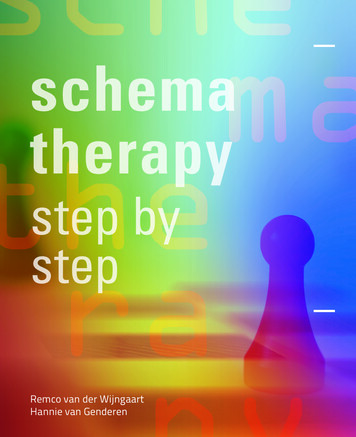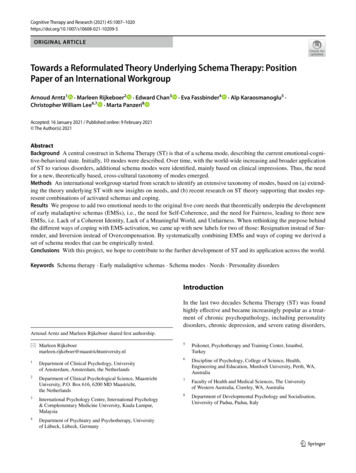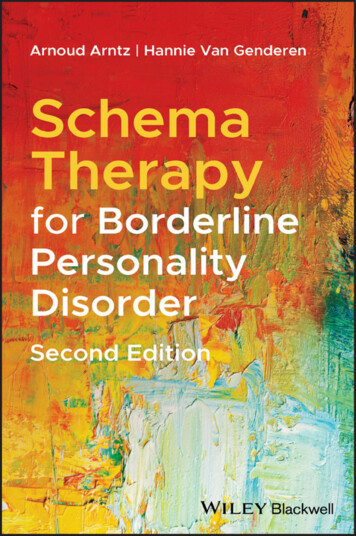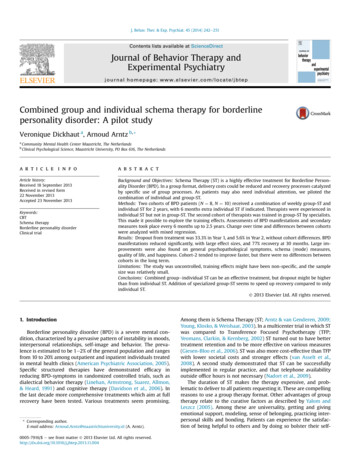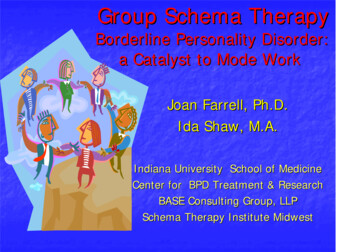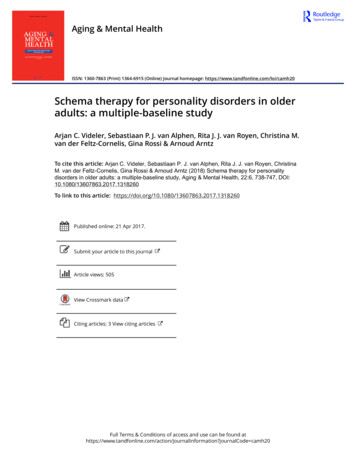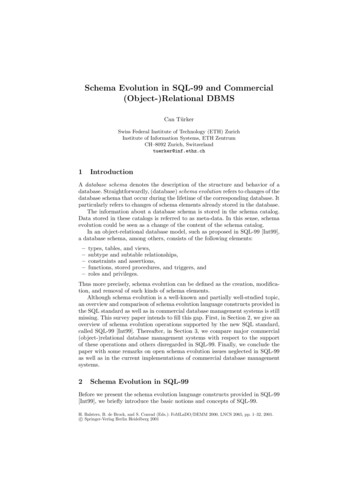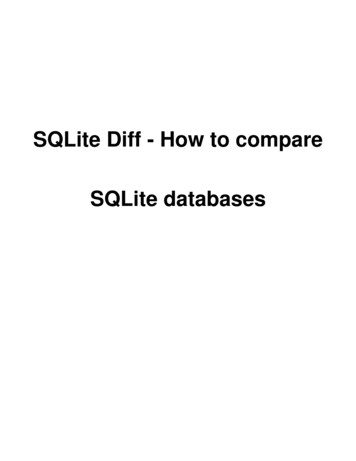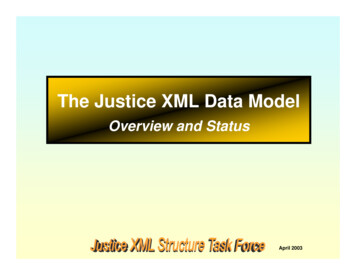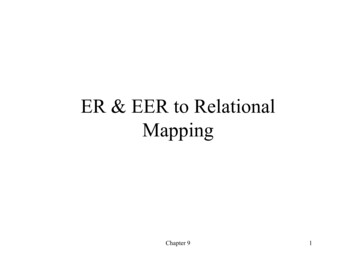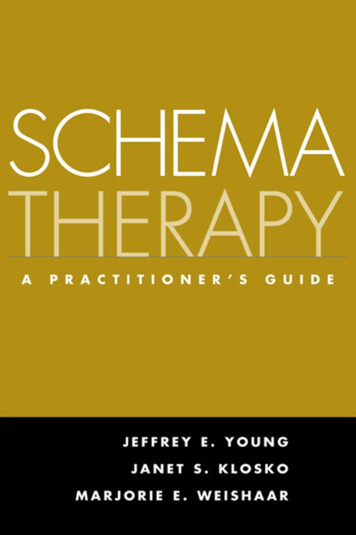
Transcription
SCHEMA THERAPY
This page intentionally left blank
SCHEMA THERAPYA Practitioner’s GuideJEFFREY E. YOUNGJANET S. KLOSKOMARJORIE E. WEISHAARTHE GUILFORD PRESSNew YorkLondon
To Debbie, Sarah, and Jacob—J. E. Y.To my mentor, Dr. David H. Barlow.All these words can’t express my gratitude.—J. S. K.To my parents—M. E. W. 2003 The Guilford PressA Division of Guilford Publications, Inc.72 Spring Street, New York, NY 10012www.guilford.comAll rights reservedNo part of this book may be reproduced, translated, stored in a retrievalsystem, or transmitted, in any form or by any means, electronic,mechanical, photocopying, microfilming, recording, or otherwise, withoutwritten permission from the Publisher.Printed in the United States of AmericaThis book is printed on acid-free paper.Last digit is print number:987654321Library of Congress Cataloging-in-Publication DataYoung, Jeffrey E., 1950–Schema therapy : a practitioner’s guide / Jeffrey E. Young,Janet S. Klosko, Marjorie E. Weishaar.p. cm.Includes bibliographical references and index.ISBN 1-57230-838-9 (hardcover : alk. paper)1. Schema-focused cognitive therapy. 2. Personality disorders—Treatment. I. Klosko, Janet S. II. Weishaar, Marjorie E. III. Title.RC455.4.S36 Y68 2003616.85′8—dc212002153858
About the AuthorsABOUT THE AUTHORSJeffrey E. Young, PhD, is on the faculty in the Department of Psychiatry atColumbia University. He is also the Founder and Director of the CognitiveTherapy Centers of New York and Connecticut, as well as the SchemaTherapy Institute (institute@schematherapy.com). Dr. Young has lecturedinternationally on cognitive and schema therapies for the past 20 years. Hehas trained thousands of mental health professionals and is widely acclaimed for his outstanding teaching skills.He is the founder of schema therapy, an integrative approach forlonger-term disorders and for treatment-resistant patients, and haspublished widely in the fields of both cognitive and schema therapies, including two major books—Cognitive Therapy for Personality Disorders:A Schema-Focused Approach, written for mental health professionals, andReinventing Your Life (with Janet S. Klosko), a popular self-help book written for the general public. Dr. Young has also served as a consultant onseveral cognitive and schema therapy research grants, including theNational Institute of Mental Health Collaborative Study of Depression, andon the editorial boards of the following journals: Cognitive Therapy andResearch and Cognitive and Behavioral Practice.Janet S. Klosko, PhD, is Codirector of the Cognitive Therapy Center ofLong Island in Great Neck, New York (516-466-8485), and is a senior psychologist at the Schema Therapy Institute in Manhattan and WoodstockWomen’s Health in Woodstock, New York (845-679-6699). She receivedher PhD in clinical psychology from the State University of New York(SUNY) at Albany and interned at Brown University Medical School.v
viAbout the AuthorsWhile at SUNY, she worked with David H. Barlow, researching and treatinganxiety disorders. Dr. Klosko has won the Albany Award for Excellence inResearch and the Dissertation Award from the American Psychological Association Section on Clinical Psychology as a Science. She has numerousacademic publications and is coauthor (with William Sanderson) of Cognitive-Behavioral Treatment of Depression, and (with Jeffrey E. Young) of thepopular book Reinventing Your Life. She also has a master’s degree in English literature.Marjorie E. Weishaar, PhD, is Clinical Professor of Psychiatry and HumanBehavior at Brown University Medical School (Marjorie Weishaar@brown.edu),where she teaches cognitive therapy to psychiatry residents and to psychology interns and postdoctoral fellows. She has also received two teaching awards from Brown Medical School. Dr. Weishaar graduated from theUniversity of Pennsylvania and earned three graduate degrees from ThePennsylvania State University. She was trained in cognitive therapy byAaron T. Beck, and in schema therapy by Jeffrey E. Young. She is the author of Aaron T. Beck, a book on cognitive therapy and its founder, whichwas recently translated into Chinese. Dr. Weishaar lectures widely and haswritten numerous articles and book chapters on cognitive therapy, particularly in the area of suicide risk. She is currently in private practice in Providence, Rhode Island.For general information about schema therapy:Schema Therapy Institute36 West 44th Street, Suite 1007New York, NY 10036Phone: 212-221-1818, ext. 5E-mail: institute@schematherapy.comWebsite: www.schematherapy.com
PrefacePREFACEIt is difficult to believe that it has been 9 years since we wrote our lastmajor book on schema therapy. During this decade of burgeoning interestin this therapy approach, we continually have been asked, “When are yougoing to write an up-to-date, comprehensive treatment manual?” Withsome embarrassment, we had to admit that we had not found the time totake on such a major project.After 3 years of intensive work, however, we have finally written whatwe hope will become “the bible” for the practice of schema therapy. Wehave attempted to include in this volume all the additions and refinementsfrom the past decade, including our revised conceptual model, detailedtreatment protocols, case vignettes, and patient transcripts. In particular,we have written extended chapters that describe a major expansion ofschema therapy for borderline and narcissistic personality disorders.During the past 10 years, many changes in the mental health fieldhave had an impact on schema therapy. As practitioners from many orientations have become dissatisfied with the limitations of orthodox therapies, there has been a corresponding interest in psychotherapy integration.As one of the first comprehensive, integrative approaches, schema therapyhas attracted many new clinicians and researchers who have been searching for both “permission” and guidance to go beyond the confines of existing models.One clear sign of this heightened interest in schema therapy has beenthe widespread use of the Young Schema Questionnaire (YSQ) by clinicians and researchers around the world. The YSQ has already been translated into Spanish, Greek, Dutch, French, Japanese, Norwegian, German,vii
viiiPrefaceand Finnish, to indicate just a few of the countries that have adopted elements of this model. The extensive research on the YSQ offers substantialsupport for the schema model.Another indication of the appeal of schema therapy has been the success of our two earlier books on schema therapy, even 10 years after theirpublication: Cognitive Therapy for Personality Disorders: A Schema-FocusedApproach is now in its third edition, and Reinventing Your Life, which hassold more than 125,000 copies, is still available at most major bookstoresand has been translated into several languages.The past decade has also seen the extension of schema therapy beyond personality disorders. The approach has been applied to a wide variety of clinical problems, populations, and disorders, including, among others, chronic depression, childhood trauma, criminal offenders, eatingdisorders, couple work, and relapse prevention for substance abuse. Oftenschema therapy is being used to treat predisposing characterological issuesin patients with Axis I disorders, once the acute symptoms have abated.Another important development has been the combining of schematherapy with spirituality. Three books (Emotional Alchemy by Tara BennettGoleman; Praying Through Our Lifetraps: A Psycho-Spiritual Path toFreedom by John Cecero; and The Myth of More by Joseph Novello) thatblend the schema approach with mindfulness meditation or with traditional religious practices have already been published.One disappointing development, that we hope will change in the decade to come, is the impact of managed care and cost containment on thetreatment of personality disorders in the United States. It has become increasingly difficult for practitioners to get insurance reimbursement andfor researchers to obtain federal grants for personality disorders becauseAxis II treatment generally takes longer and thus does not fit a short-term,managed care model. As a result, the United States has fallen behind manyother countries in supporting work on personality disorders.The result of this reduced support has been a paucity of well-designedoutcome studies with personality disorders. (The notable exception isMarsha Linehan’s dialectical behavior therapy approach to borderline personality disorder.) This has made it extremely difficult for us to obtainfunding for studies that might demonstrate empirical support for schematherapy.Thus we are turning now to other countries to fund this important research area. We are particularly excited about a major outcome study, directed by Arnoud Arntz, nearing completion in the Netherlands. Thislarge-scale, multisite study compares schema therapy with Otto Kernberg’sapproach in treating borderline personality disorder. We are eagerly awaiting the results.For readers who are unfamiliar with schema therapy, we will reviewwhat we consider the major advantages of schema therapy over other com-
Prefaceixmonly practiced therapies. Compared to most other therapy approaches,schema therapy is more integrative, combining aspects of cognitive, behavioral, psychodynamic (especially object relations), attachment, and Gestaltmodels. Schema therapy regards cognitive and behavioral components asvital to treatment, yet gives equal weight to emotional change, experientialtechniques, and the therapy relationship.Another key benefit of the schema model is its parsimony and seeming simplicity, on the one hand, combined with depth and complexity, onthe other. It is easy for both therapists and patients to understand. Theschema model incorporates complex ideas, many of which seem convoluted and confusing to patients receiving other forms of therapy, andpresents them in simple and straightforward ways. Thus schema therapyhas the commonsense appeal of cognitive-behavioral therapy (CBT), combined with the depth of psychodynamic and related approaches.Schema therapy retains two vital characteristics of CBT: It is bothstructured and systematic. The therapist follows a sequence of assessmentand treatment procedures. The assessment phase includes the administration of a number of inventories that measure schemas and coping styles.Treatment is active and directive, going beyond insight to cognitive, emotive, interpersonal, and behavioral change. Schema therapy is also valuablein the treatment of couples, helping both partners to understand and healtheir schemas.Another advantage of the schema model is its specificity. The modeldelineates specific schemas, coping styles, and modes. In addition, schematherapy is notable for the specificity of the treatment strategies, includingguidelines about providing the appropriate form of limited reparenting foreach patient. Schema therapy provides a similarly accessible method forunderstanding and working with the therapy relationship. Therapistsmonitor their own schemas, coping styles, and modes as they work withpatients.Finally, and perhaps most important, we believe that the schema approach is unusually compassionate and humane, in comparison with“treatment as usual.” Schema therapy normalizes rather than pathologizespsychological disorders. Everyone has schemas, coping styles, andmodes—they are just more extreme and rigid in the patients we treat. Theapproach is also sympathetic and respectful, especially toward the most severe patients, such as those with borderline personality disorder, who areoften treated with minimal compassion and much blame in other therapies. The concepts of “empathic confrontation” and “limited reparenting”ground therapists in a caring attitude toward patients. The use of modeseases the process of confrontation, allowing the therapist to aggressivelyconfront rigid, maladaptive behaviors, while still retaining an alliance withthe patient.In closing, we highlight some of the new developments in schema
xPrefacetherapy during the past decade: First, there is a revised and much morecomprehensive list of schemas, containing 18 schemas in five domains.Second, we have developed new, detailed protocols for the treatment ofborderline and narcissistic patients. These protocols have expanded thescope of schema therapy, primarily with the addition of the schema modeconcept. Third, there is a much greater emphasis on coping styles, especially avoidance and overcompensation, and on altering coping stylesthrough pattern-breaking. Our goal is to replace maladaptive coping styleswith healthier ones that enable patients to meet their core emotionalneeds.As schema therapy has developed and matured, we have placedmuch more emphasis on limited reparenting with all patients, but especially those with more severe disorders. Within the appropriate boundsof the therapeutic relationship, the therapist attempts to fulfill the patient’s unmet childhood needs. Finally, there is more focus on the therapist’s own schemas and coping styles, especially in regard to the therapyrelationship.We hope that this volume will provide therapists with a new way ofapproaching patients with chronic, longer-term themes and patterns, andthat schema therapy will provide significant benefits for those extremelydifficult and needy patients whom our approach is designed to treat.ACKNOWLEDGMENTSFrom All the AuthorsWe want to thank the people at The Guilford Press who supported usthroughout this long and difficult project: Kitty Moore, Executive Editor,who gave us invaluable editorial advice and helped shape the book; AnnaNelson, Production Editor, who oversaw the production of the book so diligently and was such a pleasure to work with; Elaine Kehoe, who editedthe book so beautifully; and all the other staff who worked with us.We would like to give special thanks to Dr. George Lockwood, whoprovided us with so many valuable insights and historical anecdotes aboutpsychoanalytic approaches and who donated much of the material inChapter 1 on other integrative therapies. You are a joy to work with, andwe look forward to future collaborative efforts.We would like to thank the staff at the Schema Therapy Institute inManhattan, especially Nancy Ribeiro and Sylvia Tamm. Thank you for doing so much of the work that supported our efforts. You are warm and reliable ports in a storm.Finally, we thank our patients, who have taught us about the transformation of tragedy into hope and healing.
PrefacexiJeffrey E. YoungThere are many individuals I want to thank who have played importantroles in the development of schema therapy, in the writing of this book,and in supporting me through this grueling process.To my close friends, for their love and caring over many years, and fortheir help in developing this approach. You have been like family: WendyBehary, Pierre Cousineau, Cathy Flanagan, Vivian Francesco, GeorgeLockwood, Marty Sloane, Bob Sternberg, Will Swift, Dick and DianeWattenmaker, and William Zangwill.To my colleagues, who have advanced schema therapy in many different ways, both in the United States and abroad: Arnoud Arntz, Sam Ball,Jordi Cid, Michael First, Vartouhi Ohanian, Bill Sanderson, Glenn Waller,and David Weinberger.To Nancy Ribeiro, my Executive Administrator, for her devotion inhelping me with every project, while putting up with my quirks on a dailybasis.To my father, whose unconditional love provided me with the modelfor parenting and reparenting.And, to my mentor, Tim Beck, who has been both a personal friendand a guide throughout my career.Janet S. KloskoIn addition to the above, I would like to thank my colleagues for their support, especially Dr. Jayne Rygh, Dr. Ken Appelbaum, Dr. David Bricker, Dr.William Sanderson, and Jenna Smith, CM. I would also like to thank myfamily and friends—especially Michael and Molly—for providing the secure base upon which I have built my career.Marjorie E. WeishaarI thank my teachers, especially Aaron T. Beck, MD, for their wisdom andguidance. I thank my colleagues and students for their considerable help,and I thank my family—all four generations—for their humor, optimism,probity, and sustaining love.
ContentsCONTENTSChapter 1Schema Therapy: Conceptual Model1Chapter 2Schema Assessment and Education63Chapter 3Cognitive Strategies91Chapter 4Experiential Strategies110Chapter 5Behavioral Pattern-Breaking146Chapter 6The Therapy Relationship177Chapter 7Detailed Schema Treatment Strategies207Chapter 8Schema Mode Work271Chapter 9Schema Therapy for Borderline Personality Disorder306Chapter 10 Schema Therapy for Narcissistic Personality Disorder373References425Index430xii
SCHEMA THERAPYConceptualModelChapter 1SCHEMA THERAPY:CONCEPTUAL MODELSchema therapy is an innovative, integrative therapy developed by Youngand colleagues (Young, 1990, 1999) that significantly expands on traditional cognitive-behavioral treatments and concepts. The therapy blendselements from cognitive-behavioral, attachment, Gestalt, object relations,constructivist, and psychoanalytic schools into a rich, unifying conceptualand treatment model.Schema therapy provides a new system of psychotherapy that is especially well suited to patients with entrenched, chronic psychological disorders who have heretofore been considered difficult to treat. In our clinicalexperience, patients with full-blown personality disorders, as well as thosewith significant characterological issues that underlie their Axis I disorders, typically respond extremely well to schema-focused treatment(sometimes in combination with other treatment approaches).THE EVOLUTION FROM COGNITIVE TO SCHEMA THERAPYA look at the field of cognitive-behavioral therapy1 helps to explain thereason Young felt that the development of schema therapy was so impor1Inthis section, we use the term “cognitive-behavioral therapy” to refer to various protocolsthat have been developed by writers such as Beck (Beck, Rush, Shaw, & Emery, 1979) andBarlow (Craske, Barlow, & Meadows, 2000) to treat Axis I disorders.(continued on page 2)1
2SCHEMA THERAPYtant. Cognitive-behavioral researchers and practitioners have made excellent progress in developing effective psychological treatments for Axis Idisorders, including many mood, anxiety, sexual, eating, somatoform, andsubstance abuse disorders. These treatments have traditionally been shortterm (roughly 20 sessions) and have focused on reducing symptoms,building skills, and solving problems in the patient’s current life.However, although many patients are helped by these treatments,many others are not. Treatment outcome studies usually report high success rates (Barlow, 2001). For example, in depression, the success rate isover 60% immediately after treatment, but the relapse rate is about 30% after 1 year (Young, Weinberger, & Beck, 2001)—leaving a significant number of patients unsuccessfully treated. Often patients with underlying personality disorders and characterological issues fail to respond fully totraditional cognitive-behavioral treatments (Beck, Freeman, & Associates,1990). One of the challenges facing cognitive-behavioral therapy today isdeveloping effective treatments for these chronic, difficult-to-treat patients.Characterological problems can reduce the effectiveness of traditionalcognitive-behavioral therapy in a number of ways. Some patients presentfor treatment of Axis I symptoms, such as anxiety or depression, and eitherfail to progress in treatment or relapse once treatment is withdrawn. Forexample, a female patient presents for cognitive-behavioral treatment ofagoraphobia. Through a program consisting of breathing training, challenging catastrophic thoughts, and graduated exposure to phobic situations, she significantly reduces her fear of panic symptoms and overcomesher avoidance of numerous situations. Once treatment ends, however, thepatient lapses back into her agoraphobia. A lifetime of dependence, alongwith feelings of vulnerability and incompetence—what we call her Dependence and Vulnerability schemas—prevent her from venturing out intothe world on her own. She lacks the self-confidence to make decisions andhas failed to acquire such practical skills as driving, navigating her surroundings, managing money, and selecting proper destinations. She prefersinstead to let significant others make the necessary arrangements. Withoutthe guidance of the therapist, the patient cannot orchestrate the public excursions necessary to maintain her treatment gains.Other patients come initially for cognitive-behavioral treatment of AxisI symptoms. After these symptoms have been resolved, their characterological problems become a focus of treatment. For example, a male patientundergoes cognitive-behavioral therapy for his obsessive–compulsive disorSome cognitive-behavioral therapists have adapted these protocols to work with difficult patients in ways that are consistent with schema therapy (c.f. Beck, Freeman, & Associates, 1990). We discuss some of these modifications later in this chapter (see pp. 48–53).For the most part, however, current treatment protocols within cognitive-behavioral therapydo not reflect these adaptations.
Conceptual Model3der. Through a short-term behavioral program of exposure combined withresponse prevention, he largely eliminates the obsessive thoughts and compulsive rituals that had consumed most of his waking life. Once his Axis Isymptoms have abated, however, and he has time to resume other activities,he must face the almost complete absence of a social life that is a result of hissolitary lifestyle. The patient has what we call a “Defectiveness schema,”with which he copes by avoiding social situations. He is so acutely sensitiveto perceived slights and rejections that, since childhood, he has avoidedmost personal interaction with others. He must grapple with his lifelong pattern of avoidance if he is ever to develop a rewarding social life.Still other patients who come for cognitive-behavioral treatment lackspecific symptoms to serve as targets of therapy. Their problems are vagueor diffuse and lack clear precipitants. They feel that something vital iswrong or missing from their lives. These are patients whose presentingproblems are their characterological problems: They come seeking treatment for chronic difficulties in their relationships with significant othersor in their work. Because they either do not have significant Axis I symptoms or have so many of them, traditional cognitive-behavioral therapy isdifficult to apply to them.Assumptions of Traditional Cognitive-Behavioral TherapyViolated by Characterological PatientsTraditional cognitive-behavioral therapy makes several assumptions aboutpatients that often prove untrue of those patients with characterologicalproblems. These patients have a number of psychological attributes thatdistinguish them from straightforward Axis I cases and make them lesssuitable candidates for cognitive-behavioral treatment.One such assumption is that patients will comply with the treatmentprotocol. Standard cognitive-behavioral therapy assumes that patients aremotivated to reduce symptoms, build skills, and solve their current problems and that, therefore, with some prodding and positive reinforcement,they will comply with the necessary treatment procedures. However, formany characterological patients, their motivations and approaches to therapy are complicated, and they are often unwilling or unable to complywith cognitive-behavioral therapy procedures. They may not completehomework assignments. They may demonstrate great reluctance to learnself-control strategies. They may appear more motivated to obtain consolation from the therapist than to learn strategies for helping themselves.Another such assumption in cognitive-behavioral therapy is that, withbrief training, patients can access their cognitions and emotions and reportthem to the therapist. Early in therapy, patients are expected to observeand record their thoughts and feelings. However, patients with characterological problems are often unable to do so. They often seem out of
4SCHEMA THERAPYtouch with their cognitions or emotions. Many of these patients engage incognitive and affective avoidance. They block disturbing thoughts and images. They avoid looking deeply into themselves. They avoid their owndisturbing memories and negative feelings. They also avoid many of thebehaviors and situations that are essential to their progress. This pattern ofavoidance probably develops as an instrumental response, learned becauseit is reinforced by the reduction of negative affect. Negative emotions suchas anxiety or depression are triggered by stimuli associated with childhoodmemories, prompting avoidance of the stimuli in order to avoid the emotions. Avoidance becomes a habitual and exceedingly difficult to changestrategy for coping with negative affect.Cognitive-behavioral therapy also assumes that patients can changetheir problematic cognitions and behaviors through such practices as empirical analysis, logical discourse, experimentation, gradual steps, and repetition. However, for characterological patients, this is often not the case.In our experience, their distorted thoughts and self-defeating behaviors areextremely resistant to modification solely through cognitive-behavioraltechniques. Even after months of therapy, there is often no sustained improvement.Because characterological patients usually lack psychological flexibility, they are much less responsive to cognitive-behavioral techniques andfrequently do not make meaningful changes in a short period of time.Rather, they are psychologically rigid. Rigidity is a hallmark of personalitydisorders (American Psychiatric Association, 1994, p. 633). These patientstend to express hopelessness about changing. Their characterologicalproblems are ego-syntonic: Their self-destructive patterns seem to be somuch a part of who they are that they cannot imagine altering them. Theirproblems are central to their sense of identity, and to give them up canseem like a form of death—a death of a part of the self. When challenged,these patients rigidly, reflexively, and sometimes aggressively cling to whatthey already believe to be true about themselves and the world.Cognitive-behavioral therapy also assumes that patients can engage ina collaborative relationship with the therapist within a few sessions. Difficulties in the therapeutic relationship are typically not a major focus ofcognitive-behavioral treatments. Rather, such difficulties are viewed as obstacles to be overcome in order to attain the patient’s compliance withtreatment procedures. The therapist–patient relationship is not generallyregarded as an “active ingredient” of the treatment. However, patients withcharacterological disorders often have difficulty forming a therapeutic alliance, thus mirroring their difficulties in relating to others outside of therapy. Many difficult-to-treat patients have had dysfunctional interpersonalrelationships that began early in life. Lifelong disturbances in relationshipswith significant others are another hallmark of personality disorders(Millon, 1981). These patients often find it difficult to form secure thera-
Conceptual Model5peutic relationships. Some of these patients, such as those with borderlineor dependent personality disorders, frequently become so absorbed in trying to get the therapist to meet their emotional needs that they are unableto focus on their own lives outside of therapy. Others, such as those withnarcissistic, paranoid, schizoid, or obsessive–compulsive personality disorders, are frequently so disengaged or hostile that they are unable to collaborate with the therapist. Because interpersonal issues are often the coreproblem, the therapeutic relationship is one of the best areas for assessingand treating these patients—a focus that is most often neglected in traditional cognitive-behavioral therapy.Finally, in cognitive-behavioral treatment, the patient is presumed tohave problems that are readily discernible as targets of treatment. In thecase of patients with characterological problems, this presumption is oftennot met. These patients commonly have presenting problems that arevague, chronic, and pervasive. They are unhappy in major life areas andhave been dissatisfied for as long as they can remember. Perhaps they havebeen unable to establish a long-term romantic relationship, have failed toreach their potential in their work, or experience their lives as empty. Theyare fundamentally dissatisfied in love, work, or play. These very broad,hard-to-define life themes usually do not make easy-to-address targets forstandard cognitive-behavioral treatment.Later we look at how specific schemas can make it difficult for patients to benefit from standard cognitive-behavioral therapy.THE DEVELOPMENT OF SCHEMA THERAPYFor the many reasons just described, Young (1990, 1999) developedschema therapy to treat patients with chronic characterological problemswho were not being adequately helped by traditional cognitive-behavioraltherapy: the “treatment failures.” He developed schema therapy as a systematic approach that expands on cognitive-behavioral therapy by integrating techniques drawn from several different schools of therapy. Schematherapy can be brief, intermediate, or longer term, depending on the patient. It expands on traditional cognitive-behavioral therapy by placingmuch greater emphasis on exploring the childhood and adolescent originsof psychological problems, on emotive techniques, on the therapist–patient relationship, and on maladaptive coping styles.Once acute symptoms have abated, schema therapy is appropriate forthe treatment of many Axis I and Axis II disorders that have a significantbasis in lifelong characterological themes. Therapy is often undertaken inconjunction with other
He is the founder of schema therapy, an integrative approach for longer-term disorders and for treatment-resistant patients, and has published widely in the fields of both cognitive and schema therapies, in-cluding two major books—Cognitive Therapy for Personality Disorders: A Schema-Focused Approach, written for mental health professionals, and
